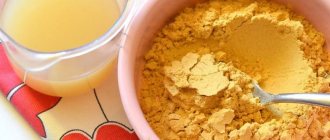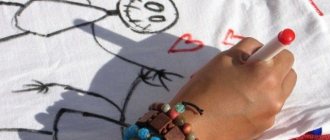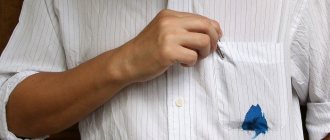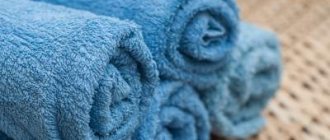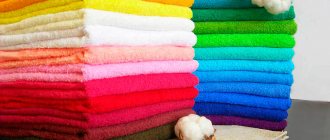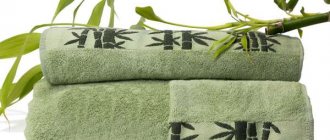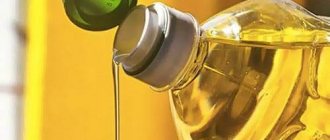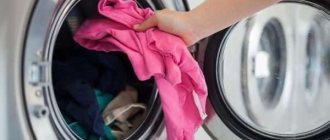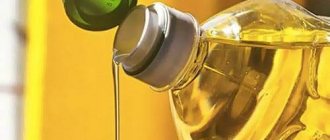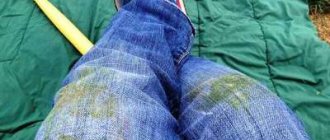/Order/
Basically, to wash kitchen towels, just throw them in the washing machine:
- White towels are washed at maximum time and temperature settings (90-100 degrees). If the towels are not too dirty, then the optimal temperature is 40-60 degrees.
- It is better to wash colored towels at a temperature of no more than 40 degrees.
However, to remove stubborn stains from, say, grease, coffee or beets, you need more serious measures and cunning tricks: boiling, soaking, using bleach and stain remover, soda, vinegar and other home remedies. We will talk about them in this article.
- The main thing is not to use radical methods more than once a month, so as not to wear out the fabric ahead of time. If you care for your kitchen towels properly, they will last for several years.
Another important note: Only white and light waffle towels can be boiled and bleached with chlorine bleach. Colored and terry napkins can be washed by hand/in the washing machine only with oxygen bleach and not for too long.
Method 2. How to wash kitchen towels in the microwave
How to wash and bleach kitchen towels without boiling? It’s very simple - create a boiling effect in the microwave. You will see that in just three minutes, most stains will disappear.
Instructions:
- Wet a kitchen towel in a bowl and rub it generously with laundry soap or any stain remover.
- Wring out the towel (not too much) and place it in a plastic bag without tying it.
- Place the tea towel bag in the microwave and run it on full power for 3 minutes.
If desired, the towels can be “boiled” in two or three batches for 3 minutes each.
- Wash towels as usual and rinse.
Stains remaining on kitchen towels can be removed locally with hydrogen peroxide (see Method 8 below).
How to remove stains from towels: soaking
The most efficient and effective way to remove stains from kitchen towels is to soak them for several hours before washing, but preferably overnight. To do this, you can use available tools:
- Salt. Helps get rid of tomato, coffee, and red wine stains. Make a solution in the proportion of 1 tbsp. salt per 1 liter of warm water, soak towels in it for at least an hour.
- Washing soap. It removes various types of stains well, including old traces of grease. Laundry soap should be grated on a coarse grater and the resulting shavings should be diluted in boiling water. Soak kitchen utensils in soapy water overnight. Another method is less labor-intensive, but no less effective. Use a bar of ordinary washing soap to wash the fabric, place it in a plastic bag and close it tightly overnight.
- Shampoo. Used to remove fruit stains from towels. The shampoo is applied directly to the stain and left for at least half an hour. For these purposes, you can use any hair washing product, including the cheapest one.
- Glycerin and ammonia. Removes traces of coffee and tea. Kitchen textiles are soaked in an aqueous solution of ammonia or washed with a mixture of glycerin and ammonia (4:1).
- Dish detergent. Dishwashing liquid is applied to dirty areas for several hours.
- Vinegar, citric acid. Add a little vinegar or lemon juice to warm water, dip towels in the mixture and leave them there for an hour.
Method 3. How to wash kitchen towels in a washing machine with bleach
This method is the first aid for dirty towels. Bleach removes grease and plant stains well, disinfects and eliminates unpleasant odors, and whitens yellowed or gray towels.
Important! Only oxygen-containing bleach is suitable for washing in the washing machine. Moreover, it is suitable for both white and colored linen. Even if your machine allows the use of bleach, you should not overuse it, as it is harmful to both the fabrics and the machine itself.
Instructions:
- Wet the towels with cold water and load them into the machine.
- Pour the required dose of bleach (most often it is 175 ml, that is, ¾ cup) into the powder receptacle compartment with the || icon, and if desired, add washing powder. It’s better to do this: first pour in the powder, let the machine pick it up, and then pour in/pour out the bleach.
- Select the desired temperature and wash time settings and start the machine. Wash light-colored towels for as long as possible at 90-100 degrees, and colored towels at 40-60 degrees.
Adviсe:
- Before pouring bleach into the cuvette, insert a special dispenser for liquid detergents into it (if your washing machine model has one).
- Do not use fabric softener as it is only good for clothes and bath towels. For kitchen textiles, conditioner is pointless - it does not eliminate, but only masks the unpleasant odor and, moreover, covers the material with a protective film, which reduces the efficiency of washing.
Whiteness, cleanliness and a pleasant smell of kitchen towels - a few tips from good housewives
And, of course, a few “life hacks” for good housewives:
- Don't throw dirty towels in the laundry basket for a week - wash them right away. It is better to soak kitchen textiles overnight than to leave them in a basket, where you will happily forget about them, and the towel itself will acquire a musty smell, which can then only be removed by a vinegar solution.
- Boiling is a great way to remove stains, but only for towels that have already been washed. First - washing, then - boiling.
- If you add starch to the water when soaking , the towels will wash better, and after washing they will get dirty and wrinkle less.
- Don't use your towels instead of potholders - this will keep them clean and overall looking longer.
- Dry kitchen towels (if possible) outside - this will keep them fresh longer.
- If you don't want to use fabric softener because it's chemical , you can use baking soda mixed with 2-3 drops of your favorite essential oil.
- Do not use the same towels for drying hands, dishes, fruits, as potholders, or for covering food.
- Do not use terry towels in your kitchen - they lose their neat appearance too quickly and absorb dirt quite easily.
- The boiling method cannot be used for colored towels , as well as textiles with decorations, embroidery, etc.
- Ironing towels after washing prolongs their cleanliness.
The site Colady.ru thanks you for your attention to the article - we hope that it was useful to you. Please share your feedback and tips with our readers!
Method 4. How to boil kitchen towels - basic instructions
Boiling can help if you don't have a washing machine at home or if your towels seem so dirty that it's easier to throw them away than try to wash them.
Important! Colored kitchen towels should not be boiled.
- Fill a large saucepan/basin/metal bucket about 2/3 full with water. Add washing powder/bleach/stain remover/other detergent to it at the rate of: 2 tablespoons of detergent per 1 liter of water (unless otherwise indicated in the product instructions).
- Place a bowl over medium heat, add towels and bring the solution to a boil. Try to stir the contents of the basin as often as possible.
- When the solution boils, reduce the heat to low and continue to cook the kitchen towels for 15 minutes to 2 hours, depending on the degree of soiling and the color of the fabric. It is better to boil colored towels for no more than 15-20 minutes; light-colored towels should be left longer. Do not forget to constantly stir the contents of the basin.
- Now that the towels have boiled, transfer them to an empty bowl using tongs and leave to cool.
- Wring out the cooled items thoroughly and rinse as usual.
Adviсe:
- Before boiling with bleach, it is advisable to first wash your towels by hand or in a washing machine.
Washing powder can be replaced with a mixture of laundry soap (72%) and soda. Grate the soap on a medium grater at the rate of 2 tablespoons per 1 liter of water, pour the shavings into the water, then add soda at the rate of 1 tbsp. spoon per 1 liter of water. Next, boil the kitchen towels in this solution, following the basic instructions above. You can also use baking soda and soap separately.
How to boil laundry at home: equipment and equipment
Before starting the procedure, study the technique of the procedure and its rules. This will protect things from deformation and save your time.
- Preparation of the solution. Dilute the treatment agent completely. If it is laundry soap, grate it. This way it will dissolve much faster.
- Sorting laundry. Separate white items from colored items, sort cotton items and linen items.
- Soak. Soak heavily soiled items in a boiling solution in advance.
- Boiling process. Place the laundry in the solution until it boils. If you throw soiled clothes into boiling water, the dirt may “cook” and you will no longer be able to wash it off. The water should completely cover the items being boiled. Do not put too many clothes: the less, the better the effect of boiling.
- Mixing. Don't forget to stir things periodically so they boil evenly. After the solution boils, reduce the heat so that the foam does not run off onto the stove.
- Disinfection. To restore whiteness and remove germs, boil already cleaned fabrics.
- Rinsing. After boiling, rinse things in cool water and wring out.
- Drying. Dry clean clothes outdoors in the sun to make them fresher and more fragrant.
Prepare the necessary equipment in advance. The procedure requires only three components.
- Pot. Take containers for boiling that are not chipped, made of enamel or stainless steel. Make sure that there is no rust on the boil-off, otherwise red marks may remain on the material that will no longer be removed.
- Forceps. Necessary for mixing laundry. Take wooden, long ones. A ladle, rolling pin or boiled stick will also work.
- Solution. There is a large selection of components. Laundry soap, bleach or Vanish stain remover are often used. The effect will be better if you combine several products at once.
Before boiling, be sure to check the information on the clothing label to see if it can be subjected to high-temperature treatment. Natural fabrics tolerate boiling well, while synthetic products become deformed during boiling.
Method 5. First aid against unpleasant odors - washing with vinegar
The simplest and most effective remedy for the stench of moldy towels is vinegar.
In the washing machine:
- Load dirty towels into the washing machine, add laundry detergent, and select the highest temperature and wash time settings.
- Pour 1/2 to 1 cup of 9% vinegar into the conditioner compartment before or during washing. During the rinse phase, the vinegar will enter the drum and remove odors.
- Remove and hang washed towels immediately after washing.
Manually:
- Soak the product for 5-10 minutes in a 5-9% vinegar solution (can be mixed with water in a 1:1 ratio).
- Rinse the towels thoroughly and hang them up immediately.
See also the material: How to clean the iron inside and outside - 10 home methods.
Method 6. How to whiten kitchen towels without bleach (3 home remedies)
- Using mustard powder. This method can both disinfect and bleach kitchen towels. To do this, dry mustard powder is diluted in hot water to a thick paste, after which the mixture is applied to wet towels, left for 6-8 hours and finally washed.
- Using potassium permanganate. This is a very effective method that works almost always. For a basin of boiling water you need about 200 g of washing powder and a little potassium permanganate (the water should be only slightly pink). Place pre-washed items in the solution, cover the basin with film and wait until the water has cooled completely. Finally, rinse the towels well.
- Using boric acid. This method is suitable for washing thick, waffle or terry towels. Add 2 tablespoons of boric acid to a bowl of hot water, then soak dirty towels in the resulting solution for 2 hours. Finally, wash them as usual and rinse them.
Methods for cleaning kitchen textiles
You can wash textiles using various chemicals, as well as using improvised means. You can effectively bleach laundry at home using the following methods.
Machine or hand wash
If the towel is not too dirty or has not been used much, you can wash it in a machine. You need to choose the appropriate powder and set the correct washing mode. For colored fabrics, the temperature should be 50−60° C, for white cotton - up to 90° C.
You can wash towels by hand if you don't have too many of them. To do this, use powder or laundry soap with a concentration of 72%. It is recommended to use hand washing powder designed for a specific type of fabric and color. Then the towels will look clean and fresh. You need to soap the towels and leave them for 30 minutes, then rub them a little and rinse them in warm water.
Soaking dirty towels
If the towels are very dirty, soaking them before washing can help. In order to wash white textiles, you need to dilute the washing powder and add 5 tbsp to the container. l. soda Keep in this solution for up to 5 hours . This method will also rid the fabric of unpleasant odors.
Colored fabrics lose their color when exposed to soda, so salt is used for them. You need to prepare a solution of 1 tbsp. l. salt and 1 liter of water. Leave for an hour. After soaking, you need to wash it in a machine or by hand. You can also soak using any stain remover, following the instructions on the package.
Boiling from stubborn stains
This method is the most radical, but at the same time the most effective. It allows you to wash any, even the dirtiest things. By boiling you can get rid of very stubborn stains. Please note that only white or pastel-colored fabrics can be boiled. Colored ones will fade in boiling water.
If there are old stains , then before boiling you need to apply a special stain remover to them. After 10-15 minutes, soak in hot water with the same stain remover and leave for several hours. Then you can start boiling. For this process, you need to take an enameled pan or bucket. Pour hot water into a container, add washing powder and bleach, preferably oxygen. Place towels there. Then the pan is placed on the fire and the contents are boiled for 1 hour. Then you need to rinse the towels thoroughly and dry them.
Boiling laundry to whiten is widely used by modern housewives because of its effectiveness. But we must remember that it cannot be used often, since boiling water has a negative effect on the fabric itself, destroying the fibers.
Method 7. How to remove stains with citric acid
Citric acid can remove stains of various origins, but is especially effective at removing stains from beets and tomatoes.
Instructions:
- First, wash the towel with laundry soap under running hot water and wring it out a little.
- Sprinkle citric acid on the stains and leave for 5 minutes. If the stains are old, leave the towel on for an hour.
- Rinse as usual.
Question answer
- How to wash kitchen towels in a washing machine correctly? Firstly, temperature is important. As we have already noted, a temperature of 90-100 degrees is suitable for white products, and 40-60 degrees for colored products. Secondly, it is best to wash kitchen towels separately from clothes, linen, etc. Third tip: if necessary, it is better to pre-soak very dirty towels.
- How to achieve the best whitening results? First, the laundry needs to be washed or soaked with powder and only then proceed to bleaching.
- What's the best way to store dirty kitchen towels at home? This method is perhaps the most convenient: hang a basket or small bag (preferably mesh) on a hook somewhere in the kitchen. The towels will dry and be stored there until wash day. And if you allocate a place nearby for storing clean towels, then changing kitchen textiles will become even more convenient.
- How often should I wash and change towels? Ideally, once a day, especially if you are an active cook, have a large family and cook several times every day. Another tip: try to wash and change towels after drying your hands/cutting board/utensils when cooking raw meat, fish or eggs.
- Which towels are more practical? For wiping dishes, surfaces, vegetables and fruits, it is better to have waffle or smooth kitchen towels.
- But terry towels are appropriate in the kitchen only for drying hands, as dirt accumulates in them more quickly. To make your kitchen towels less dirty at first, try ironing them after washing.
- How many towels should there be in the kitchen? Typically, a duty set includes: a hand towel, a towel for wiping dishes and vegetables, and, if desired, a towel for wiping work surfaces, sinks, and cutting boards (in addition to a rag). In any case, you can’t have too many towels in the kitchen, because the more often we change them, the less we dirty them and wear them out with aggressive washing.
- How to prevent odor? Air dry your kitchen towels before putting them in the laundry hamper. After washing, try to immediately hang the items, ideally dry them in the sun or on a hot radiator. To ensure your textiles have a pleasant aroma, add a mixture of baking soda and your favorite essential oil to the water when rinsing kitchen towels.
Support the project - share the material with your friends on social networks:
Tips and prohibitions
It is recommended to take into account the following tips and prohibitions:
- heavily soiled items must be soaked before washing;
- before bleaching, it is better to first wash the item or soak it in powder for a couple of hours;
- in the kitchen it is better to use waffle towels, as well as products with a smooth texture;
- Terry towels should not be used for wiping dishes, sinks, cabinets and food;
- To prevent the appearance of a musty smell from textiles, it is always necessary to dry them well before washing;
- Kitchen towels must be changed every two days.
It is recommended to use cotton and linen textiles in the kitchen. They are easier to wash.
Terry products should not be kept in the kitchen. They get dirty quickly. To get rid of the musty smell, it is recommended to soak the item for 3 hours in a soda-based solution before washing.
It is better to dry textiles in the sun . After washing, it is recommended to iron the items. This way they will get dirty less often.
